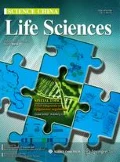References
Batzer, M.A., and Deininger, P.L. (2002). Alu repeats and human genomic diversity. Nat Rev Genet 3, 370–379.
Bennett, G.M., and Moran, N.A. (2013). Small, smaller, smallest: the origins and evolution of ancient dual symbioses in a phloem-feeding insect. Genome Biol Evol 5, 1675–1688.
Bennetzen, J.L., and Wang, H. (2014). The contributions of transposable elements to the structure, function, and evolution of plant genomes. Annu Rev Plant Biol, 65, 505–530.
Genovese, G., Handsaker, R.E., Li, H., Altemose, N., Lindgren, A.M., Chambert, K., Pasaniuc, B., Price, A.L., Reich, D., Morton, C.C., et al. (2013). Using population admixture to help complete maps of the human genome. Nat Genet 45, 406–414.
Grant, V. (1975). Genetics of Flowering Plants (New York: Columbia University Press).
Hou, Y., and Lin, S. (2009). Distinct gene number-genome size relationships for eukaryotes and non-eukaryotes: gene content estimation for dinoflagellate genomes. PLoS ONE 4, e6978.
Brosius, J. (2019). Exaptation at the molecular genetic level. Sci China Life Sci 62, 437–452.
Kellner, M., and Makałowski, W. (2019). Transposable elements significantly contributed to the core promoters in the human genome. Sci China Life Sci 62, 489–497.
Kolmogorov, M., Kennedy, E., Dong, Z., Timp, G., and Pevzner, P.A. (2017). Single-molecule protein identification by sub-nanopore sensors. PLoS Comput Biol 13, e1005356.
Koonin, E.V., and Wolf, Y.I. (2008). Genomics of bacteria and archaea: the emerging dynamic view of the prokaryotic world. Nucleic Acids Res 36, 6688–6719.
Makino, T., Knowles, D.G., and McLysaght, A. (2010). Functional divergence of duplicated genes. In Evolution after Gene Duplication. (Wiley-Blackwell). pp. 23–30.
McHale, L.K., Haun, W.J., Xu, W.W., Bhaskar, P.B., Anderson, J.E., Hyten, D.L., Gerhardt, D.J., Jeddeloh, J.A., and Stupar, R.M. (2012). Structural variants in the soybean genome localize to clusters of biotic stressresponse genes. Plant Physiol 159, 1295–1308.
Messing, J., Bharti, A.K., Karlowski, W.M., Gundlach, H., Kim, H.R., Yu, Y., Wei, F., Fuks, G., Soderlund, C.A., Mayer, K.F.X., et al. (2004). Sequence composition and genome organization of maize. Proc Natl Acad Sci USA 101, 14349–14354.
Platt II, R.N., Vandewege, M.W., and Ray, D.A. (2018). Mammalian transposable elements and their impacts on genome evolution. Chromosome Res 26, 25–43.
Ranz, J., and Clifton, B. (2019). Characterization and evolutionary dynamics of complex regions in eukaryotic genomes. Sci China Life Sci 62, 467–488.
Ren, L., Huang, W., Cannon, E.K.S., Bertioli, D.J., and Cannon, S.B. (2018). A mechanism for genome size reduction following genomic rearrangements. Front Genet 9, 454.
Soltis, P.S., Marchant, D.B., Van de Peer, Y., and Soltis, D.E. (2015). Polyploidy and genome evolution in plants. Curr Opin Genet Dev 35, 119–125.
Wenger, A.M., Peluso, P., Rowell, W.J., Chang, P.C., Hall, R.J., Concepcion, G.T., Ebler, J., Fungtammasan, A., Kolesnikov, A., Olson, N.D., et al. (2019). Accurate circular consensus long-read sequencing improves variant detection and assembly of a human genome. Nat Biotechnol 37, 1155–1162.
Zhang, W., Gao, Y., Long, M., and Shen, B. (2019). Origination and evolution of orphan genes and de novo genes in the genome of Caenorhabditis elegans. Sci China Life Sci 62, 579–593.
Zhao, Q., Feng, Q., Lu, H., Li, Y., Wang, A., Tian, Q., Zhan, Q., Lu, Y., Zhang, L., Huang, T., et al. (2018). Pan-genome analysis highlights the extent of genomic variation in cultivated and wild rice. Nat Genet 50, 278–284.
Author information
Authors and Affiliations
Corresponding author
Ethics declarations
The author(s) declare that they have no conflict of interest.
Rights and permissions
About this article
Cite this article
Chen, S., Huang, X. DNA sequencing: the key to unveiling genome. Sci. China Life Sci. 63, 1593–1596 (2020). https://doi.org/10.1007/s11427-020-1709-6
Received:
Accepted:
Published:
Issue Date:
DOI: https://doi.org/10.1007/s11427-020-1709-6

